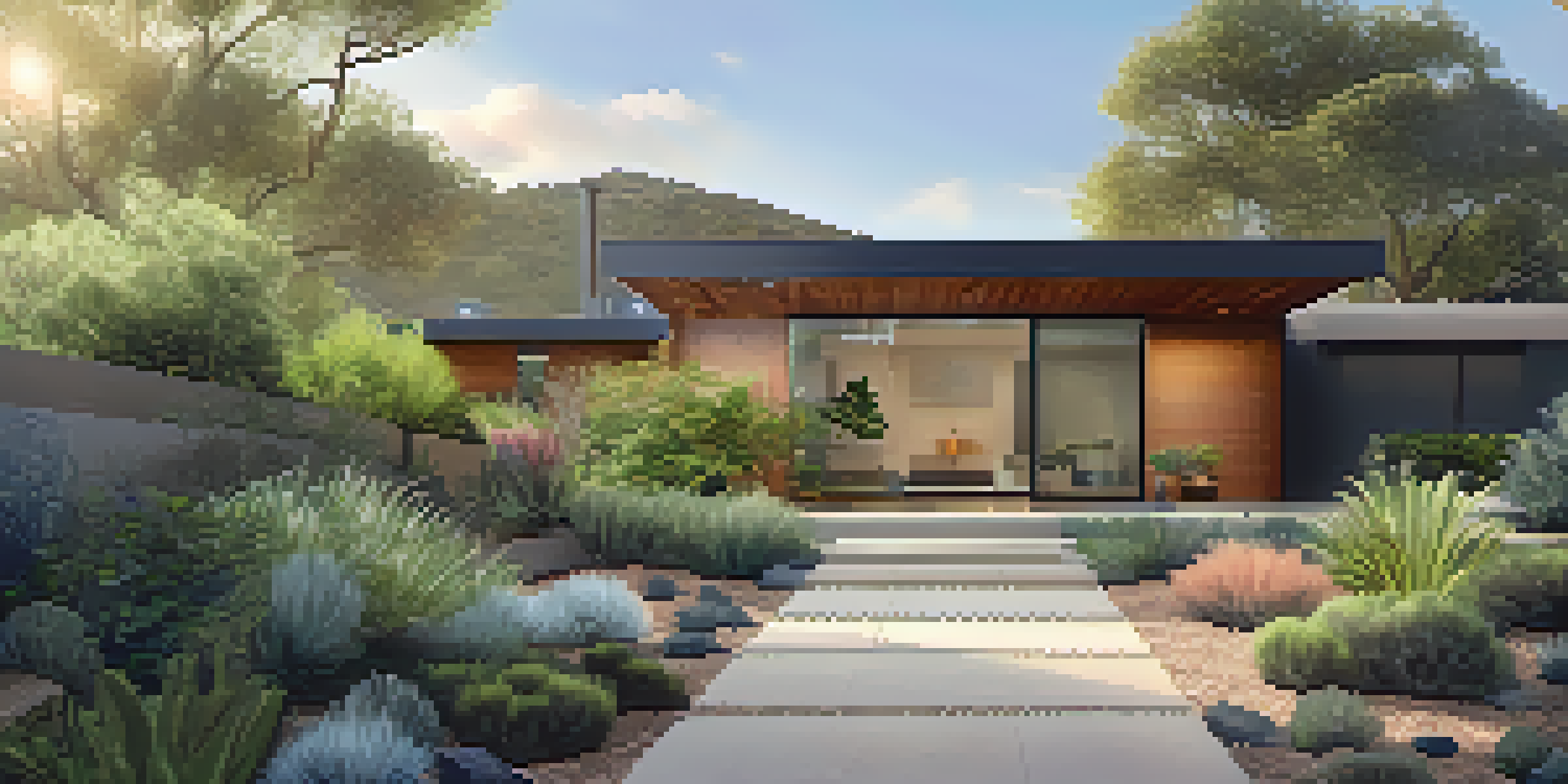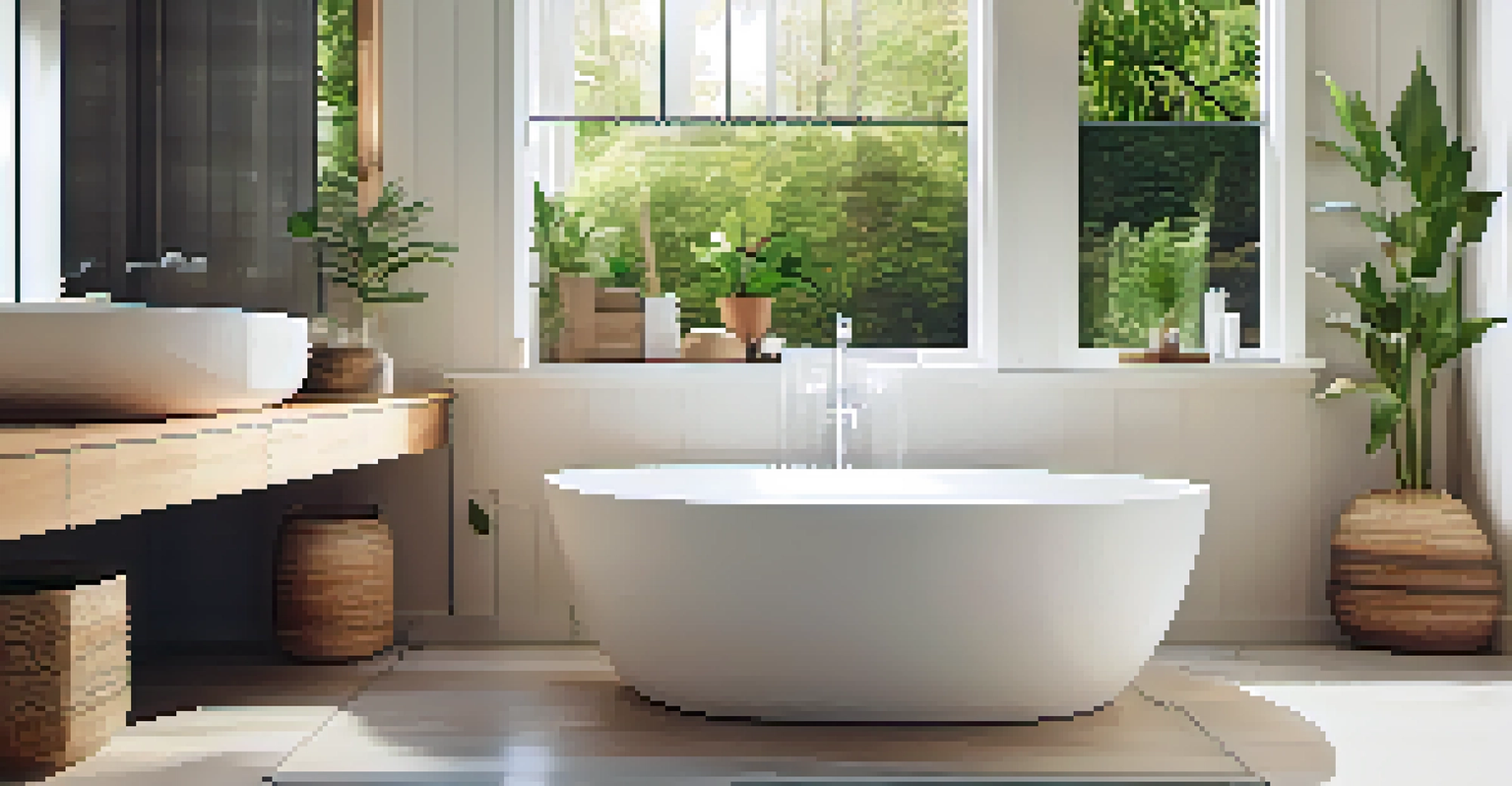Water Conservation: Future Trends in Home Design

The Importance of Water Conservation in Home Design
Water conservation has become a crucial aspect of modern home design, primarily due to increasing water scarcity. Homeowners are recognizing that sustainable practices not only benefit the environment but can also lead to significant savings on utility bills. As we face climate change and urbanization, the need for efficient water use has never been more pressing.
Water is the driving force of all nature.
By incorporating water-saving technologies into homes, we can dramatically reduce our overall consumption. This shift not only helps to protect natural water resources but also supports the well-being of communities by ensuring access to clean water. Home design is evolving to embrace these practices, making sustainability a key priority.
Furthermore, water conservation in home design encourages a lifestyle that values resourcefulness. It empowers homeowners to take a proactive approach in managing their water usage, fostering a sense of stewardship over this vital resource. As we look to the future, these principles are becoming foundational in how we think about our living spaces.
Smart Technology: The Future of Water Management
Smart home technology is revolutionizing how we manage water usage. Devices like smart irrigation systems can adjust watering schedules based on weather conditions, ensuring that plants receive just the right amount of moisture. This not only conserves water but also keeps gardens thriving with minimal effort from homeowners.

Additionally, smart meters provide real-time data on water consumption, allowing homeowners to identify leaks or excessive use instantly. By using these insights, individuals can make informed decisions to reduce waste. The integration of technology in home design is creating a more responsive and efficient approach to water management.
Water Conservation is Essential
Incorporating sustainable practices in home design not only benefits the environment but also leads to significant savings on utility bills.
As we embrace these advancements, the potential to save water becomes more significant. Future homes equipped with smart technology will not only enhance convenience but also promote environmental responsibility. This aligns with a growing trend where homeowners seek to make choices that reflect their commitment to sustainability.
Rainwater Harvesting: A Sustainable Solution
Rainwater harvesting is gaining traction as an effective method for conserving water in home design. By collecting and storing rainwater from roofs, homeowners can utilize this resource for irrigation, toilet flushing, and even laundry. This practice reduces reliance on municipal water systems and helps to alleviate pressure on local water supplies.
We do not inherit the earth from our ancestors; we borrow it from our children.
The design of systems for rainwater capture can be seamlessly integrated into new homes, often going unnoticed while providing significant benefits. Homeowners can install cisterns or other storage solutions that keep rainwater ready for use. This not only promotes sustainability but also enhances the resilience of homes against drought conditions.
As awareness of climate impacts grows, the interest in rainwater harvesting continues to rise. It represents a shift toward self-sufficiency in water use, encouraging homeowners to take an active role in their environmental footprint. The future of home design will likely see this practice becoming more mainstream and normalized.
Xeriscaping: Landscaping for Water Efficiency
Xeriscaping is a landscaping approach that minimizes water use through the selection of drought-resistant plants. By designing gardens that thrive on minimal irrigation, homeowners can significantly reduce their water consumption while still enjoying beautiful outdoor spaces. This technique is particularly useful in arid regions where water is scarce.
Incorporating xeriscaping into home design not only conserves water but also reduces maintenance efforts, as these plants require less care. Homeowners can choose native plants that are already adapted to their local climate, further enhancing the effectiveness of this approach. This creates a harmonious relationship between the landscape and the surrounding environment.
Smart Tech Enhances Water Management
Smart home devices, like irrigation systems and meters, allow homeowners to manage water usage efficiently and reduce waste.
As xeriscaping becomes more popular, it encourages a shift in mindset about traditional landscaping practices. Homeowners are beginning to see the value in embracing natural beauty that aligns with sustainable living. This trend is likely to continue, shaping the future of residential design.
Dual-Flush Toilets: A Simple Change with Big Impact
Dual-flush toilets are a simple yet effective innovation in water conservation for homes. By offering two different flush options, these toilets allow users to choose a lower volume for liquid waste and a higher volume for solid waste. This can lead to significant water savings in the long run, especially in households with multiple users.
The adoption of dual-flush technology is growing as homeowners become more aware of their environmental impact. This small change can make a big difference, with some models saving up to 67% more water than traditional toilets. As part of a broader trend toward water-efficient fixtures, dual-flush toilets are becoming a common feature in modern home design.
With the emphasis on sustainability, dual-flush toilets represent an easy upgrade for homeowners looking to reduce their water usage without sacrificing comfort or convenience. As we move forward, these toilets will likely become a standard element in eco-friendly home design.
Water-Efficient Appliances: The New Norm
Water-efficient appliances are transforming home design by providing sustainable options for everyday tasks. Dishwashers and washing machines now come equipped with features that minimize water usage while maintaining performance. Homeowners can save both water and energy, making these appliances a smart choice for modern living.
The efficiency of these appliances is not just about conserving water; it also translates to lower utility bills. As manufacturers continue to innovate, we can expect to see even greater improvements in water-saving technology. This trend reflects a growing consumer demand for products that align with eco-friendly values.
Education Drives Conservation Efforts
Educating homeowners and future generations about water-saving practices fosters a culture of sustainability in communities.
Integrating water-efficient appliances into home design is becoming increasingly accessible, with many options available on the market. Homeowners are encouraged to consider these choices as part of their commitment to sustainability. The future of home design will undoubtedly include a focus on appliances that prioritize water conservation.
The Role of Education in Promoting Water Conservation
Education plays a vital role in promoting water conservation within home design. As homeowners become more informed about the benefits of sustainable practices, they are more likely to implement water-saving measures in their homes. Workshops and community programs can empower individuals with the knowledge they need to make a difference.
Schools and local organizations can also contribute by teaching children about the importance of water conservation. By instilling these values at a young age, we can cultivate a generation that prioritizes sustainability. This collective effort is essential for fostering a culture of conservation in our communities.

As awareness grows, the demand for water-efficient home designs will likely increase. Homeowners who are educated about water conservation will be more inclined to seek out properties that reflect these values. Ultimately, education is a powerful tool that can drive meaningful change in how we approach water use.